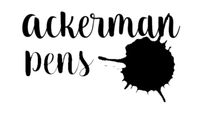Using our Sketch nibs
Many people are surprised to find out that paper can wear down metal. Drawing and writing with a metal nib wears down the tip of the nib that touches paper. That’s why traditional fountain pen nibs are tipped with a tough material. That’s also why fountain pen nibs expensive.
This is not an issue with dip nibs. These nibs are not designed for a long life. Cheap dip nibs, such as the Gillott 303, will usually rust or snap before the tip wears down. They are made from inexpensive spring steel and will start rusting the moment you first stick the nib in ink. A old fashioned professional illustrator working in pen and ink usually goes through two or three Gillott 303 nibs a day.
Higher quality nibs, such as the Zebra Manga G nib, can last longer, but not much longer. If you take care of your Zebra Manga G nibs, they might last for a few weeks, but they will degrade in various ways as you use them.
|
The highest quality drawing nibs are fountain pen nibs, which have a tough material welded to the tip of the nib that inhibits wear and tear. You can see the nib tips on the right. They are different shapes and sizes, which determine the type of line that is drawn by each nib. |
 |
You should polish tipped nibs from time to time to make sure the tip stays smooth. Fountain pen nibs can last for many years if they are taken care of properly.
Our Sketch nibs fall somewhere between dip nibs and fountain pen nibs. They are not tipped, but they are made with a durable material that won’t rust, snap, or break. The tip will wear down over time and with use. That’s why we suggest you learn how to polish your Sketch nibs so they remain in top operating shape. It doesn’t take much time or trouble to polish a nib, and it helps you pay attention to the way your nib behaves.
We provide a piece of lapping film you can use. You can order more sheets if you need them.
Note: If you find yourself without lapping film, you can also use paper from a brown shopping bag. We suggest you wet the paper first, just enough water to make the surface a bit smoother.
Two key tricks to successful polishing
There are two ways to keeping your Sketch nibs smooth.
- Use a light hand. Position the nib lightly onto the lapping paper. The more you press, the more material you will remove from the nib. Just let the nib skate over the paper.
- Check your progress frequently. Make a few swirls of the nib on the paper, then check your results. It doesn't take much effort to remove scratchiness from the nib, and you don't want to remove more material than is necessary.
The best way to smooth a nib is to draw a few tight circles, then test your progress. You can polish nibs with ink in the pen if that’s easiest. We recommend using a dry nib, but the difference is not crucial.
|
Some people recommend drawing figure 8s, others say continuous tight circles are better. Find what works best for you. Don’t polish for more than five to ten seconds. Test your first pass by drawing on paper. If you’re polishing with a dry nib, dip the nib into ink, then draw on your favorite drawing paper. You can also dip the nib into water if that is more convenient. |
 |
Try to determine whether the nib feels smooth. If it doesn’t, polish again, just a few more circles. This time roll the nib so you polish all undersides of the tip. You decide when you're finished by the feel of the nib on paper. Check again to see if the nib catches on the paper. If yes, polish that spot of the nib.
As the final step, make sure the tynes or sides of the nib are aligned correctly and one tyne isn't "cocked" or riding above the other. You can adjust the tynes easily by pressing on them.
Reshaping your Sketch nib
Smoothing the nib means removing nicks and burrs from your nib tip that arise from abrasion with paper. Reshaping your nibs means removing more material to make the tip of your nib into a different shape so the drawn line is different. Reshaping can have dramatic effects on the performance of the nib.
 |
The most common reshaping is done to make a stub nib, as shown in the middle on the left. To get the stub shape, trim off the tip so it is flat, like a chisel. Another example is to turn the nib into a “leftie” for left handed people. In this case, you reshape the nib to match the general shape of your left foot, as shown on the right side. |
All three nibs shown above are examples of the first version of our Sketch nib. We include one of these nibs with each Sketch nib pen so you can use it to practice polishing and reshaping your nibs.
Reshaping is more extreme than polishing. Removing material from the nib changes the behavior of the nib, and doing this correctly so you get the right behavior takes practice and experience. You can make broad nibs finer but you can’t make them broader.
For more information on polishing nib, read Notes for Richard Binder's Nib Smoothing Workshop.